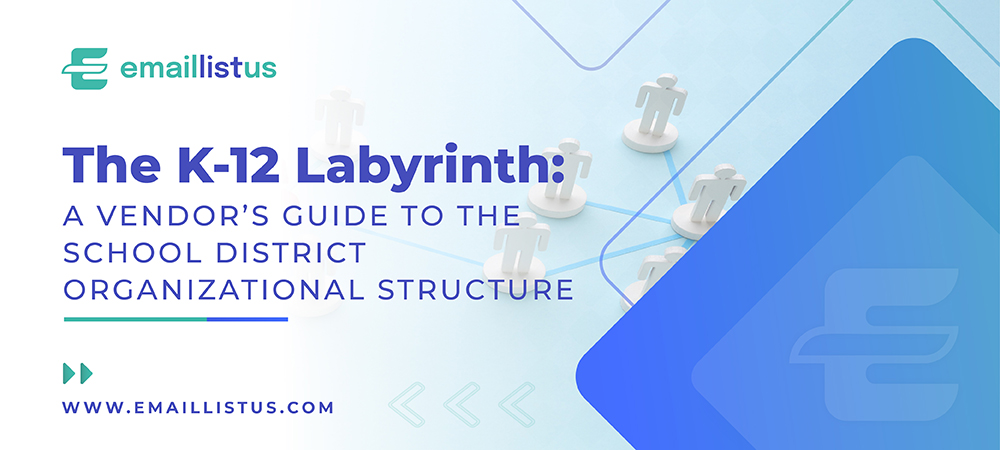Selling into the K-12 education system can feel like navigating a complex labyrinth. You have a groundbreaking product that could revolutionize learning, but who do you talk to? Is it the teacher in the classroom, the principal, a mysterious figure at the “district office,” or the superintendent? Misunderstanding the intricate organizational structure of a school district is the single most common reason why promising EdTech and K-12 service companies fail to gain traction.
The truth is, a school district is not a single entity but a complex ecosystem of departments, roles, and influencers, each with its own priorities, budget, and power to say “yes,” “no,” or “not right now.” To succeed, you must understand this hierarchy and the flow of purchasing decisions within it. This guide will illuminate the path, demystifying the key roles from the boardroom to the classroom, and helping you identify not just the decision-makers, but the crucial influencers who can champion your solution.
Level 1: Governance & Vision – The School Board and Superintendent
At the apex of every school district are two key entities: the Board of Education and the Superintendent.
- The Board of Education (School Board): This is an elected or appointed body of community members that governs the district. They are the ultimate authority, responsible for setting district-wide policy, approving the annual budget, and hiring the superintendent.
- Purchasing Power: The Board holds the ultimate purse strings. They give final approval on large-scale expenditures, major curriculum adoptions, and significant technology infrastructure projects. You will rarely sell directly to the board, but their strategic goals and approved budget create the landscape in which all other purchasing decisions are made. Your goal is to align your product’s value proposition with the district’s strategic plan, which the Board champions.
- The Superintendent: The Superintendent is the CEO of the school district, hired by the School Board to execute its vision and manage the district’s day-to-day operations. They are the public face of the district and the leader of the administrative cabinet.
- Purchasing Power: While the Superintendent can be a powerful champion for a product, they typically delegate specific purchasing decisions to their cabinet-level chiefs. They are the final administrative approver before a large contract goes to the board.
- Influencers: The Superintendent is influenced by their cabinet, community feedback, state and federal mandates, and data on district performance.
Level 2: The Cabinet – Central Office Leadership
Reporting directly to the Superintendent is a cabinet of chief officers or assistant superintendents. These are the primary decision-makers for their respective verticals and the most important people for vendors to understand.
- Chief Academic Officer (CAO) / Assistant Superintendent of Curriculum & Instruction:
- Role: This person is in charge of everything related to teaching and learning. This includes curriculum, instructional materials, professional development, and assessment. This department is often the epicenter of purchasing activity for educational software, textbooks, and learning platforms.
- Decision-Makers: The CAO.
- Key Influencers: Directors of Elementary/Secondary Education, Curriculum Coordinators (for Math, ELA, Science, etc.), Instructional Coaches, and Teacher Leaders. These influencers are often tasked with vetting new materials and running pilot programs. A “yes” from a Curriculum Coordinator is often the most critical step toward getting a “yes” from the CAO.
- Chief Information/Technology Officer (CIO/CTO):
- Role: The CIO is responsible for the district’s entire technology ecosystem, including network infrastructure, student information systems (SIS), data privacy, and device management.
- Decision-Makers: The CIO/CTO is the final word on any technology purchase. They are the ultimate gatekeeper, ensuring any new product is secure, compatible with existing systems, and scalable.
- Key Influencers: Director of IT, Network Manager, Systems Administrator, and Data Security Analyst. These individuals evaluate the technical merits of a product. If your product creates a security risk or a support nightmare, they will advise the CIO against it, effectively killing the deal.
- Chief Financial Officer (CFO) / Business Manager:
- Role: The CFO manages the district’s budget, procurement, payroll, and all financial operations.
- Decision-Makers: The CFO ensures that funds are available and that the purchase complies with district and state procurement laws. They approve purchase orders. While they don’t typically select a product, they can halt any purchase that isn’t fiscally sound or doesn’t follow protocol.
- Key Influencers: Purchasing Director, Procurement Officers, and Grant Coordinators. Understanding their timelines and paperwork requirements is non-negotiable.
- Chief Operating Officer (COO) / Director of Operations:
- Role: This department handles the physical side of the district: facilities, transportation, food services, and safety.
- Decision-Makers: The COO or relevant director (e.g., Director of Facilities) makes purchasing decisions related to building maintenance, security systems, transportation logistics, and cafeteria supplies.
Level 3: The School Level – Where Policy Meets Practice
While central office holds the power for district-wide adoption, individual schools are where the magic happens and where significant influence is wielded.
- The Principal: The principal is the instructional and operational leader of their school. They manage their own school-based budget, which can be used for supplemental software, professional development, and building-specific supplies.
- Purchasing Power: Principals are key decision-makers for site-based licenses and pilot programs. A successful pilot at a few schools, championed by enthusiastic principals, is the best way to build a case for a district-wide adoption.
- Influencers: Assistant Principals, Department Chairs (in middle/high schools), and teacher leaders.
- The Teacher: Teachers are the ultimate end-users. While they rarely have direct purchasing authority, their influence is immense.
- Purchasing Power: Almost zero for significant purchases. They may have a small classroom budget ($100-$500).
- Influencers: Teachers are the most powerful grassroots influencers. If teachers love a product, they will tell their principal, their instructional coach, and their colleagues. If they find a product difficult to use or ineffective, their negative feedback can quickly poison a pilot program. Many district decisions are made by committees composed largely of teachers. Winning them over is a critical, long-term strategy.
Modeling the Decision Process
A purchase decision isn’t a single event but a function of multiple variables. We can represent this conceptually. Let Papproval be the final approval for a significant purchase. This approval is a function of alignment across several key areas:
Papproval=f(Salign,Bconfirm,Tvalid,Ibuy_in)
Where:
- Salign represents alignment with the district’s Strategic Goals.
- Bconfirm represents confirmation of Budget availability and procurement compliance from the CFO.
- Tvalid represents the technical Validation and security approval from the CIO/CTO.
- Ibuy_in represents the Instructional Buy-In from the CAO’s department and end-users (teachers/principals).
For a vendor, success means satisfying all variables in this equation. You must prove your solution helps the district achieve its strategic goals, fits the budget, is technologically sound, and, most importantly, will be embraced by educators to improve student outcomes. Navigating the K-12 labyrinth requires a multi-pronged approach that respects the role of every person in this complex, interconnected system.
Ensure your marketing efforts reach the heart of educational decision-making by connecting directly with school principals, superintendents, and other pivotal influencers. Our Build a List platform is your gateway to accurate, updated K12 data, providing exclusive access to over 1000 school and district personnel, including principals and superintendents, plus contacts from 500+ colleges and universities. Dive into our Build a List section now and begin forging invaluable connections with the leaders shaping the future of education.








